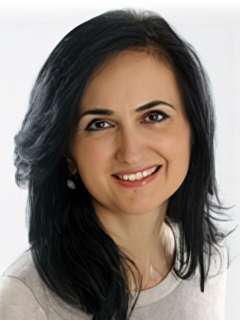
Slavica Tudzarova-Trajkovska, PhD
Languages
Contact Information
Phone
Scientific Interests
The initiation of DNA replication represents a committing step in cell proliferation, depending upon the non-overlapping activity of two enzymes, S-phase CDK2 (S-CDK2) and Dbf4-dependent CDC7 (DDK) kinase. Crosstalk between DNA replication initiation and cell cycle progression is an essential component of the program to maintain genome integrity, and it is guarded by multiple checkpoints. G1-S transition checkpoints govern the decision to allow or to prohibit DNA synthesis, depending on the level of metabolic reserves, bioenergetics and the integrity of DNA. Defects in G1-S checkpoints commonly occur during malignant transformations.
Dr. Slavica Tudzarova-Trajkovska's research aims to answer the following fundamental questions:
- How do human cells couple the cell cycle machinery to cellular metabolism essential for G1-S progression?
- How does cellular energetics integrate mitochondrial function and the initiation of DNA replication?
- How do cells monitor and control the start of DNA replication under genotoxic stress?
- What is the role of p53-CDC7 regulatory pathway in the stem cell homeostasis and cellular regeneration?
Her recent work has elucidated the metabolic nature of the restriction point in G1-S, in which APC/C-Cdh1 plays a fundamental role by linking the all-important provision of glucose and glutamine to messages required for cell duplication. Expression of PFKFB3, an enzyme essential for the enhancement of glycolysis, is detectable concomitantly with other proteins responsible for G1 to S phase progression. PFKFB3 protein and a peak in the rate of lactate production are present only transiently at G1-S, following a decrease in the activity of the ubiquitin ligase APC/C-Cdh1, which targets PFKFB3 for degradation. The subsequent upregulation of glycolysis by PFKFB3 provides the glucose necessary for the synthesis of macromolecules. Her current research explores the role of transient glycolysis in the proliferative cell cycle of pancreatic beta cells and induced pluripotent stem cells (iPSC) with emphasis on the translation of the mitochondrial dynamics and cellular bioenergetics to DNA replication initiation.
Tudzarova-Trajkovska recently discovered the origin of the activation checkpoint (OAC) that monitors the activation of replicative origins and is sensitive to reduced levels of CDC7. OAC critically relies on multiple regulatory axes coordinated through the Forkhead transcription factor FoxO3a. SILAC-based high resolution MS proteomics showed that the arrested phenotype of normal fibroblasts involves active rather than passive cellular and metabolic adaptation, and that the Cdc7-depleted proteome maintains cellular arrest by initiating a dynamic quiescence-like and catabolic response that promotes cellular survival. OAC reliance on several tumor suppressor proteins commonly inactivated in human tumors provides a strong mechanistic basis for the differential killing of tumor versus normal cells after CDC7 inhibition/downregulation. The therapeutic targeting of the DNA replication initiation machinery thus constitutes one of the focuses of her research.
Genotoxic stress stimulates a molecular response to suppress CDK2 activity, which relies on p53-induced transcription of p21WAF1. However, the p53 stress pathway has evolved multiple strategies which combine transcriptional, post-transcriptional and post-translational mechanisms to prevent G1-S transition and DNA replication initiation under genotoxic stress. Her present work investigates how genotoxic stress initiates tumor suppressor response to modify CDC7 initiation kinase levels and function, and maintain genome integrity.
Highlighted Publications
Mulvey CM, Tudzarova S, Crawford M, Williams GH, Stoeber K, Godovac-Zimmermann J. Subcellular proteomics reveals a role for nucleo-cytoplasmic trafficking at the DNA replication origin activation checkpoint. J Proteome Res. 2013 Mar 1;12(3):1436-53. doi: 10.1021/pr3010919. Epub 2013 Feb 6.
Tudzarova S, Colombo SL, Stoeber K, Carcamo S, Williams GH, Moncada S. Two ubiquitin ligases, APC/C-Cdh1 and SKP1-CUL1-F (SCF)-beta-TrCP, sequentially regulate glycolysis during the cell cycle. Proc Natl Acad Sci U S A. 2011 Mar 29;108(13):5278-83. doi: 10.1073/pnas.1102247108. Epub 2011 Mar 14.
Colombo SL, Palacios-Callender M, Frakich N, Carcamo S, Kovacs I, Tudzarova S, Moncada S. Molecular basis for the differential use of glucose and glutamine in cell proliferation as revealed by synchronized HeLa cells. Proc Natl Acad Sci U S A. 2011 Dec 27;108(52):21069-74. doi: 10.1073/pnas.1117500108. Epub 2011 Nov 21.
Tudzarova S, Trotter MW, Wollenschlaeger A, Mulvey C, Godovac-Zimmermann J, Williams GH, Stoeber K. Molecular architecture of the DNA replication origin activation checkpoint. EMBO J. 2010 Oct 6;29(19):3381-94. doi: 10.1038/emboj.2010.201. Epub 2010 Aug 20.
Mulvey C, Tudzarova S, Crawford M, Williams GH, Stoeber K, Godovac-Zimmermann J. Quantitative proteomics reveals a "poised quiescence" cellular state after triggering the DNA replication origin activation checkpoint. J Proteome Res. 2010 Oct 1;9(10):5445-60. doi: 10.1021/pr100678k.